Mac Acting Super Funny Things Crashing

Why Is My Mac Running Slow? 5 Quick Tips to Speed Up Your Mac!
Trying to figure out why your precious Mac is running slow and want to learn how to make it run faster? Mac troubleshooting can pb you down a rabbit hole of problem-solving that takes hours to diagnose and fifty-fifty days to resolve. Nevertheless, the process of speeding up that slow Mac can be a lot easier with Parallels® Toolbox utilities for Mac and Parallels Toolbox for Windows.
We're hither to assistance accost the top five problems that cause Mac performance to ho-hum down. These are the following topics we'll go over for irksome Mac tips:
- You take resource-heavy applications running in the background.
- A lack of hard drive space.
- You're in dire need of a hardware upgrade.
- A tiresome power-up/boot.
- Out-of-date software.
As a bonus, we'll also cover helpful ane-click tools that tin save time, money, and apace free up your precious disk space—without annoying micromanagement of your system.
Resource-Heavy Applications Running in Background
Any MacBook slows down over time thanks to… developers.
Their applications stay in the processes and drain your system, even when y'all don't use them.
Luckily, yous can substantially increase battery life, bandwidth, and system resources by simply quitting the applications that you may not fifty-fifty know be.
Activity Monitor is a built-in utility that comes with the macOS. It's an invaluable resource that helps users empathize where their system'due south resources are being allocated in existent time. Users can view their CPU, memory, network, disk activity, and usage, as well as individual tasks.
You can easily troubleshoot your Mac with the Activity Monitor by understanding what is happening "behind the scenes" or "nether the hood," simply many casual users don't even know that Activity Monitor exists. It's valuable to think of the Activity Monitor equally the Mac equivalent to PCs' Task Director—aka the CTRL+Alt+Delete on a Mac. I'll walk you through how to utilise the Activity Monitor to manually micromanage resource-heavy applications running in the background.
Start on the macOS Desktop to become to the Action Monitor. Follow this pathway:
Finder > Get > Utilities
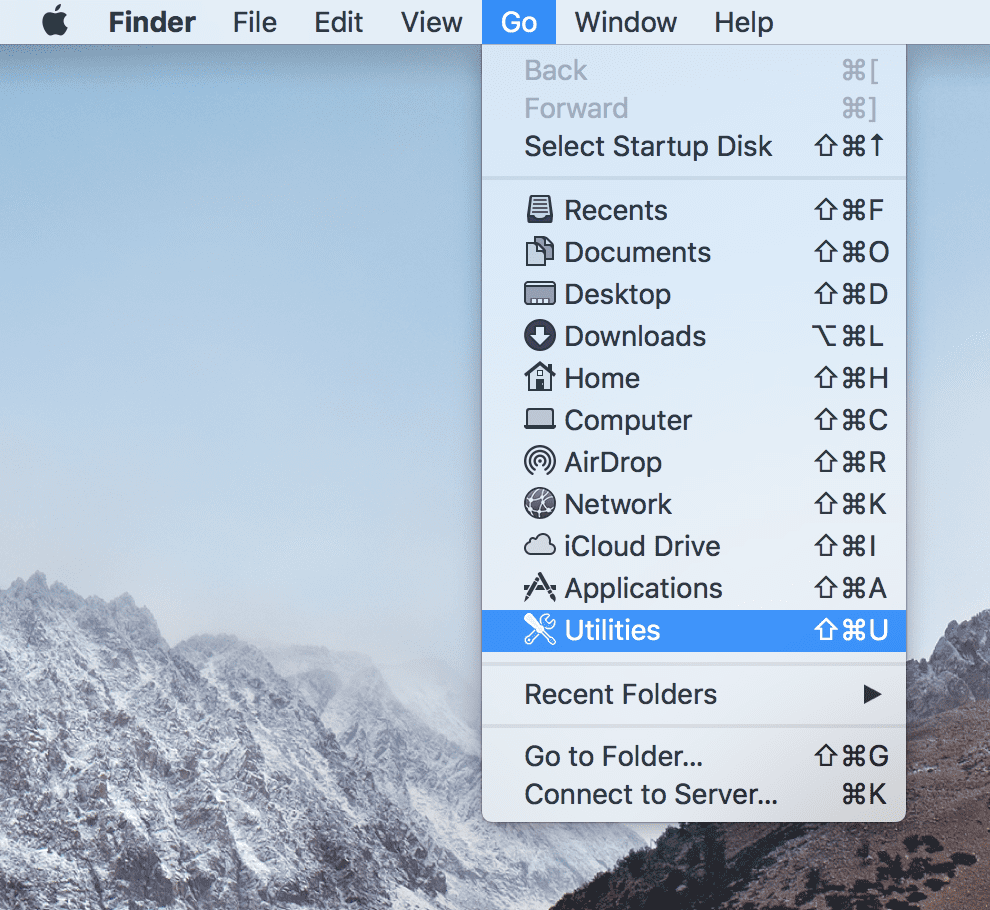
Once you launch your Utilities folder, it should expect like this:
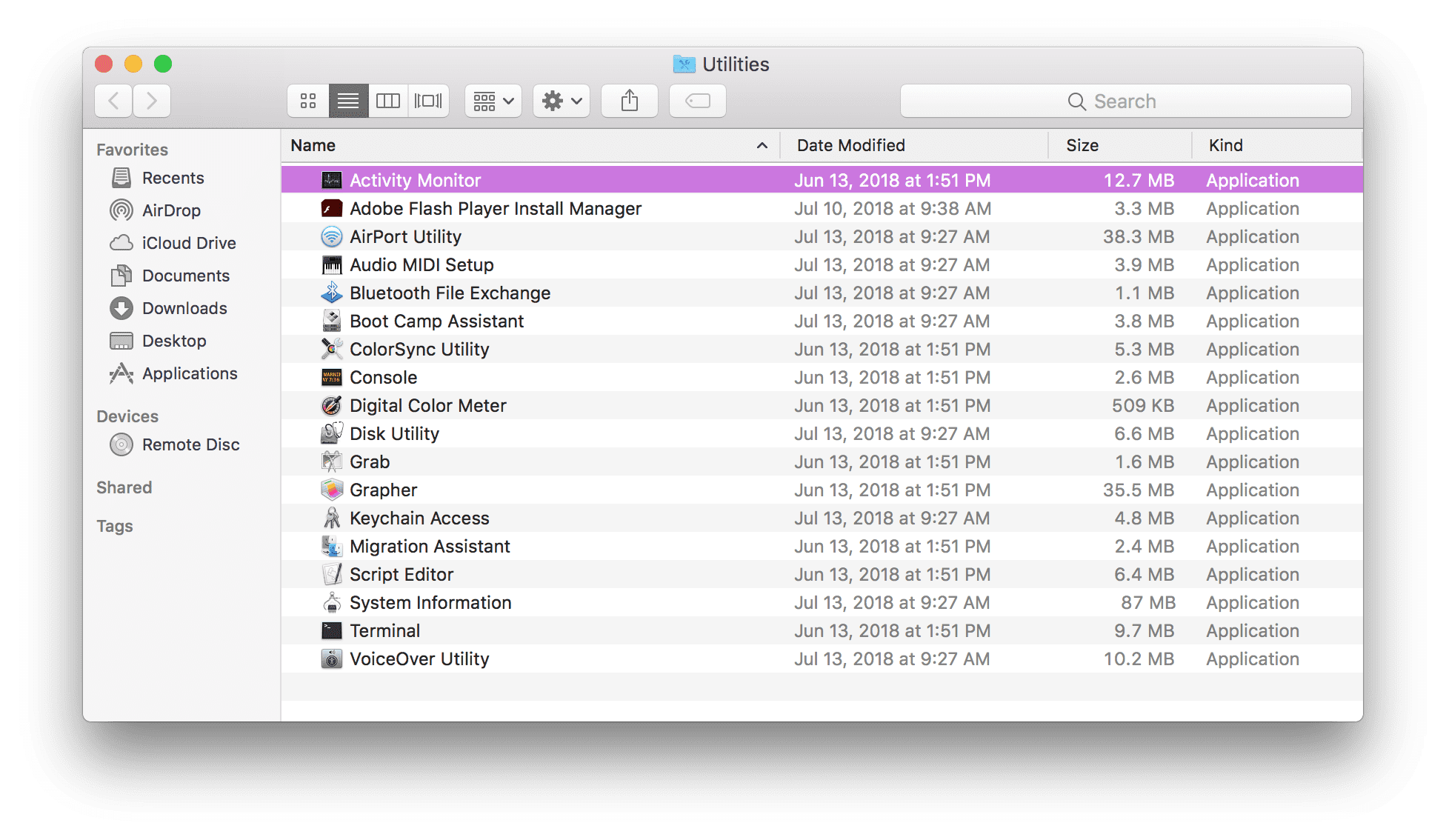
Select Activity Monitor, and it will testify y'all the tiptop applications in the terminal 12 hours, with real-fourth dimension data regarding free energy impact, battery info, and more.
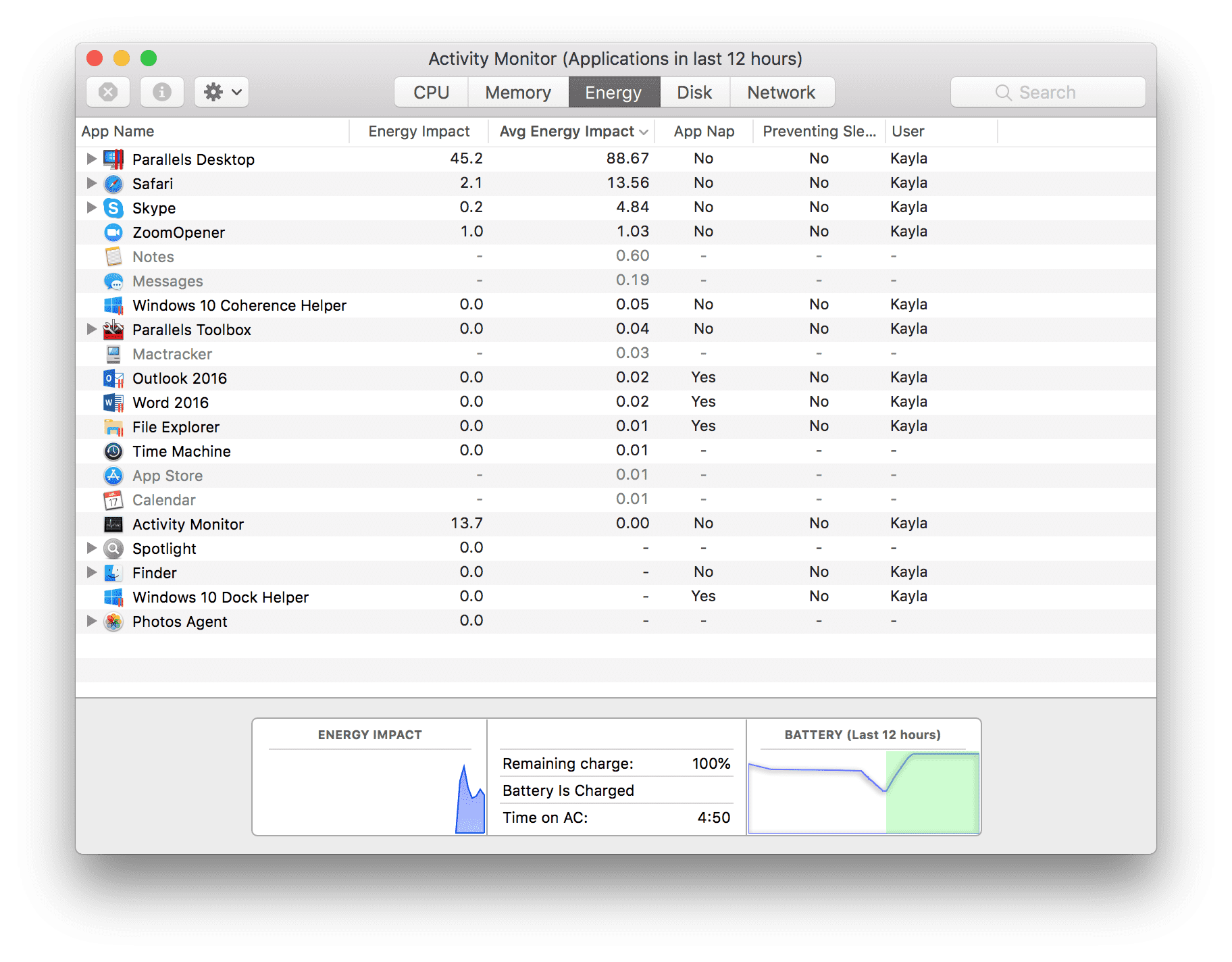
Experience free to explore the top five tabs, organized by CPU, Retention, Energy, Disk, and Network. Pay shut attention to what programs are causing large impacts to these tabs. If these are running in the background and y'all had no idea they were even open, go ahead and double-click the Procedure Name or App Name to find out more details most retentiveness, statistics, open files, and ports.
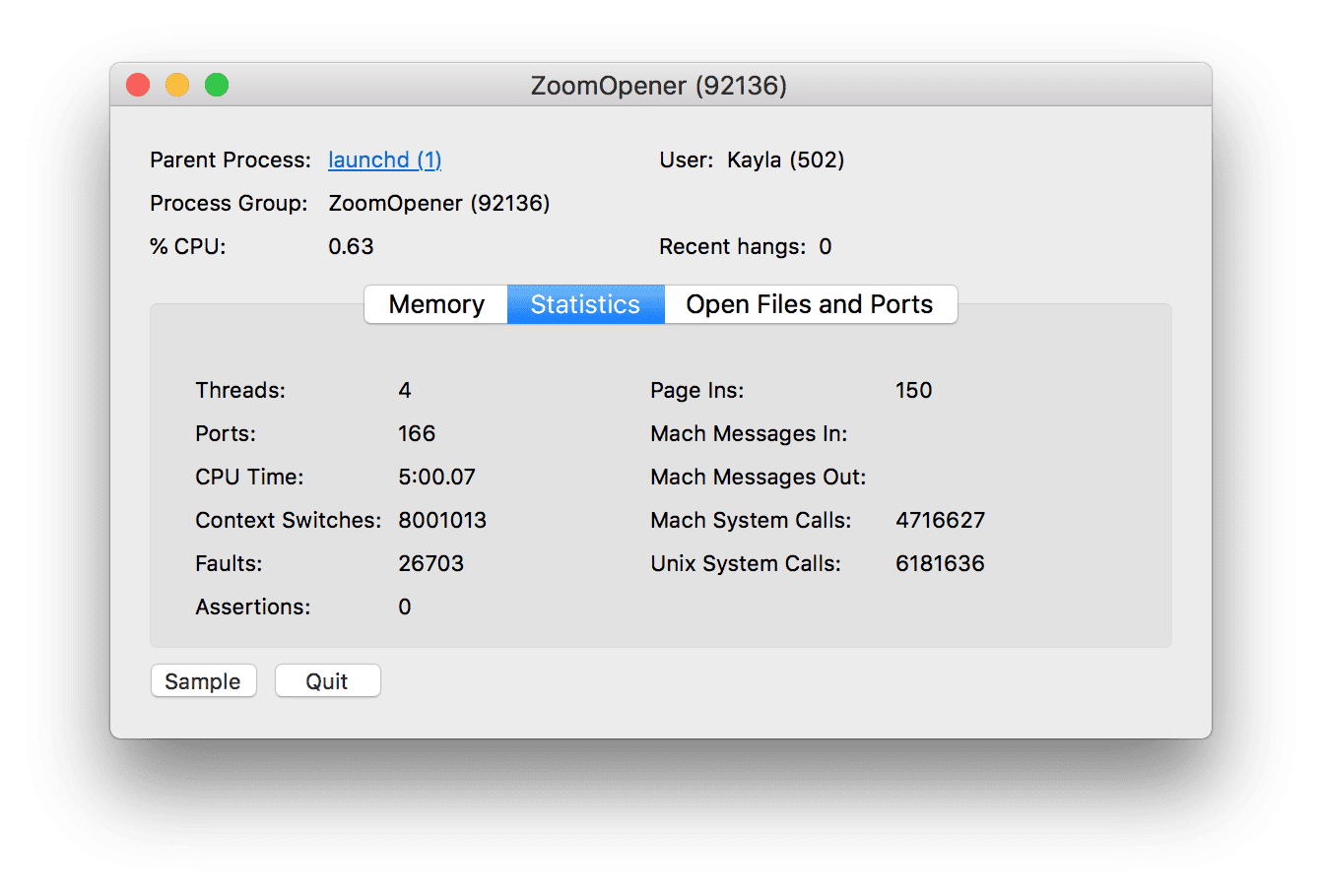
You can then force the application to quit as desired in the above window.
Mac is Running Slow due to Lack of Hard Drive Infinite
Running out of space may not simply ruin your system performance—it can besides cause the applications y'all're working with to crash. That happens because macOS is constantly swapping memory to disk, specially for setups with low initial RAM.
Nosotros start addressing this problem by understanding exactly what our Mac is capable of. Brainstorm past exploring the difficult bulldoze and deejay infinite available. Go alee and follow this pathway:
Apple Logo > Virtually This Mac
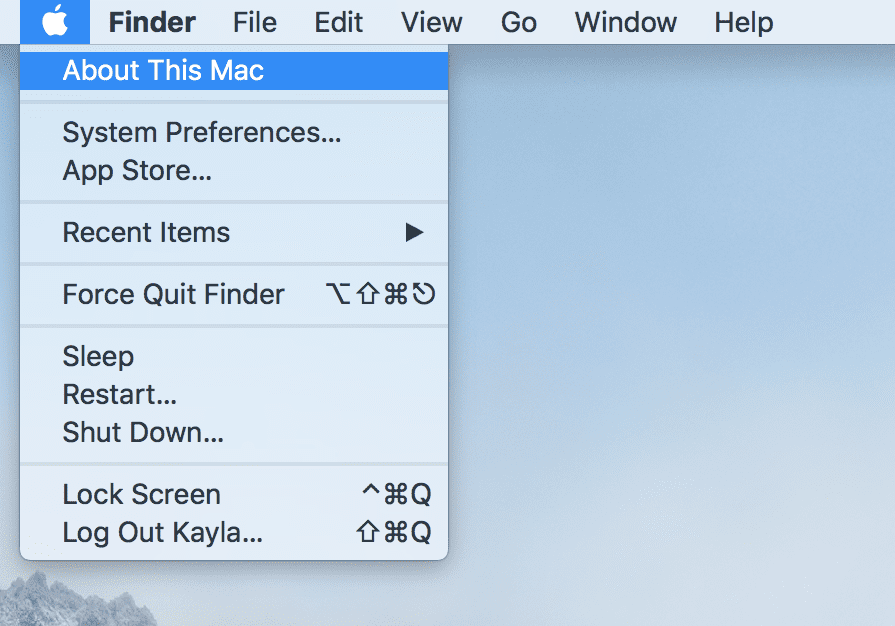
Clicking "About This Mac" will bring up an Overview of your Mac, processor, memory, startup deejay, graphics, and series number:
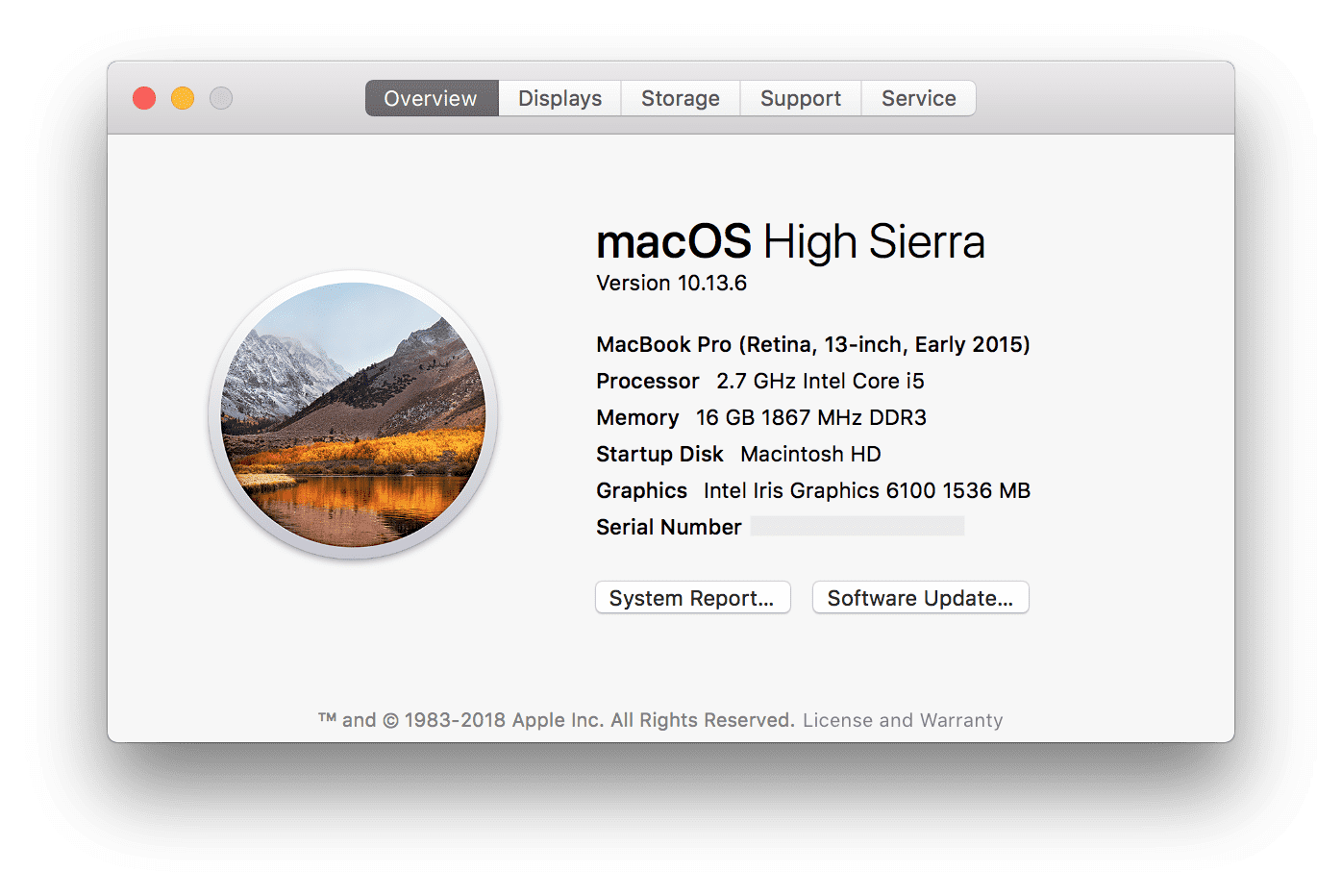
At the pinnacle of this window, there will be a five tabs to assist users navigate through their Mac system data. Select the "Storage" tab to run into a helpful simply generalized breakdown of your Macintosh HD storage usage, similar to this image: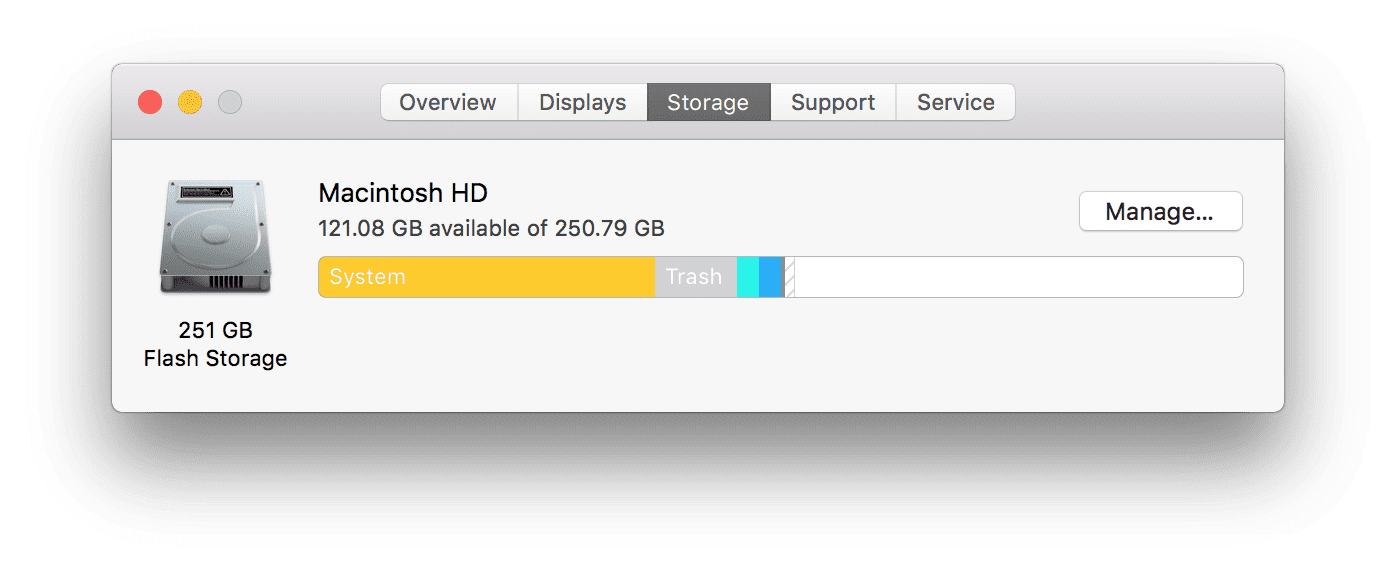
In this window, you will see the "Manage…" button located on the right-hand side. This is where the magic happens. Click that button to come across macOS Organisation Information and a detailed breakup of your storage usage.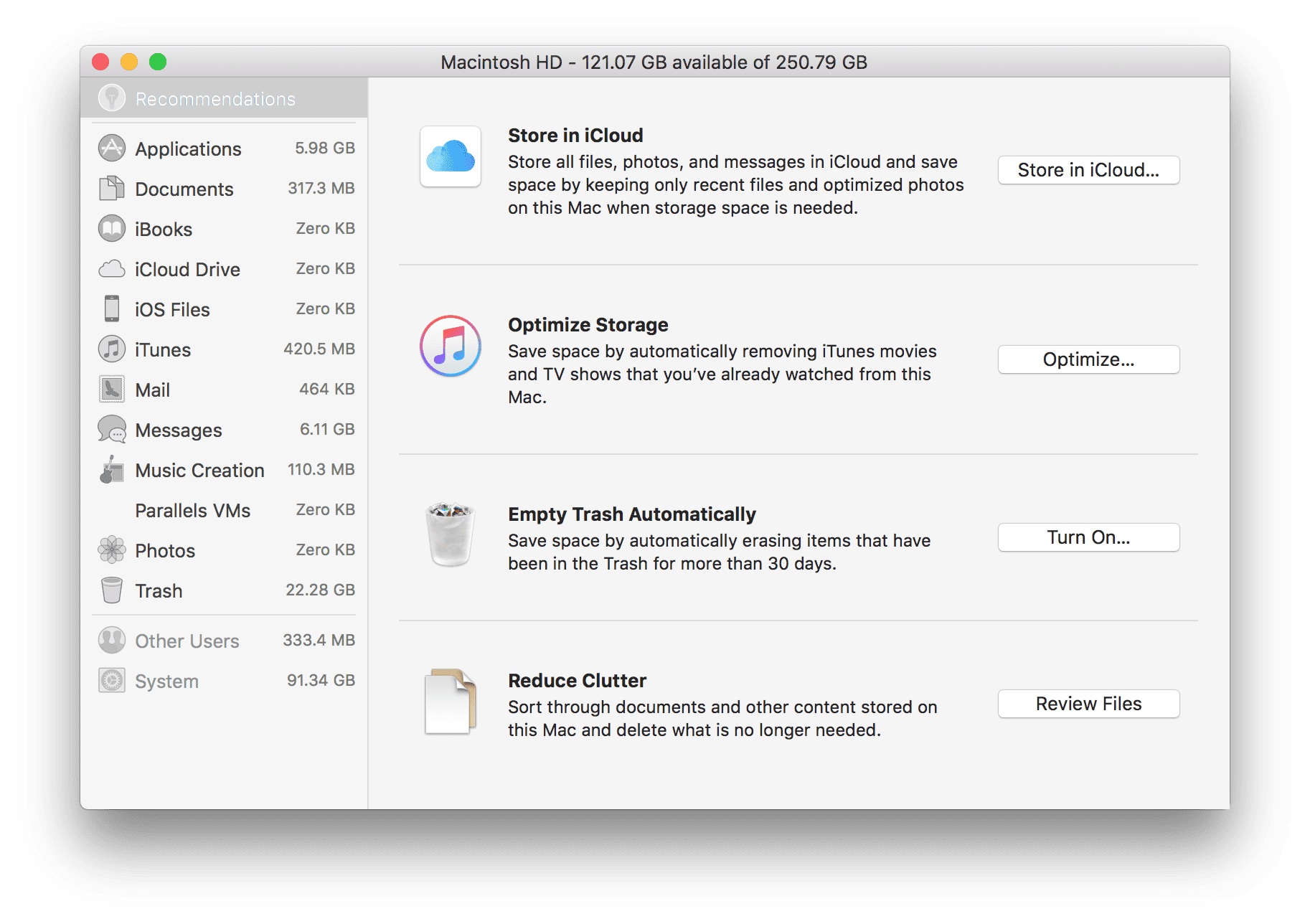
Here you lot have iv automatic recommendations for saving space on your hard drive. Earlier you cull which ane to use, I'll walk you through each selection.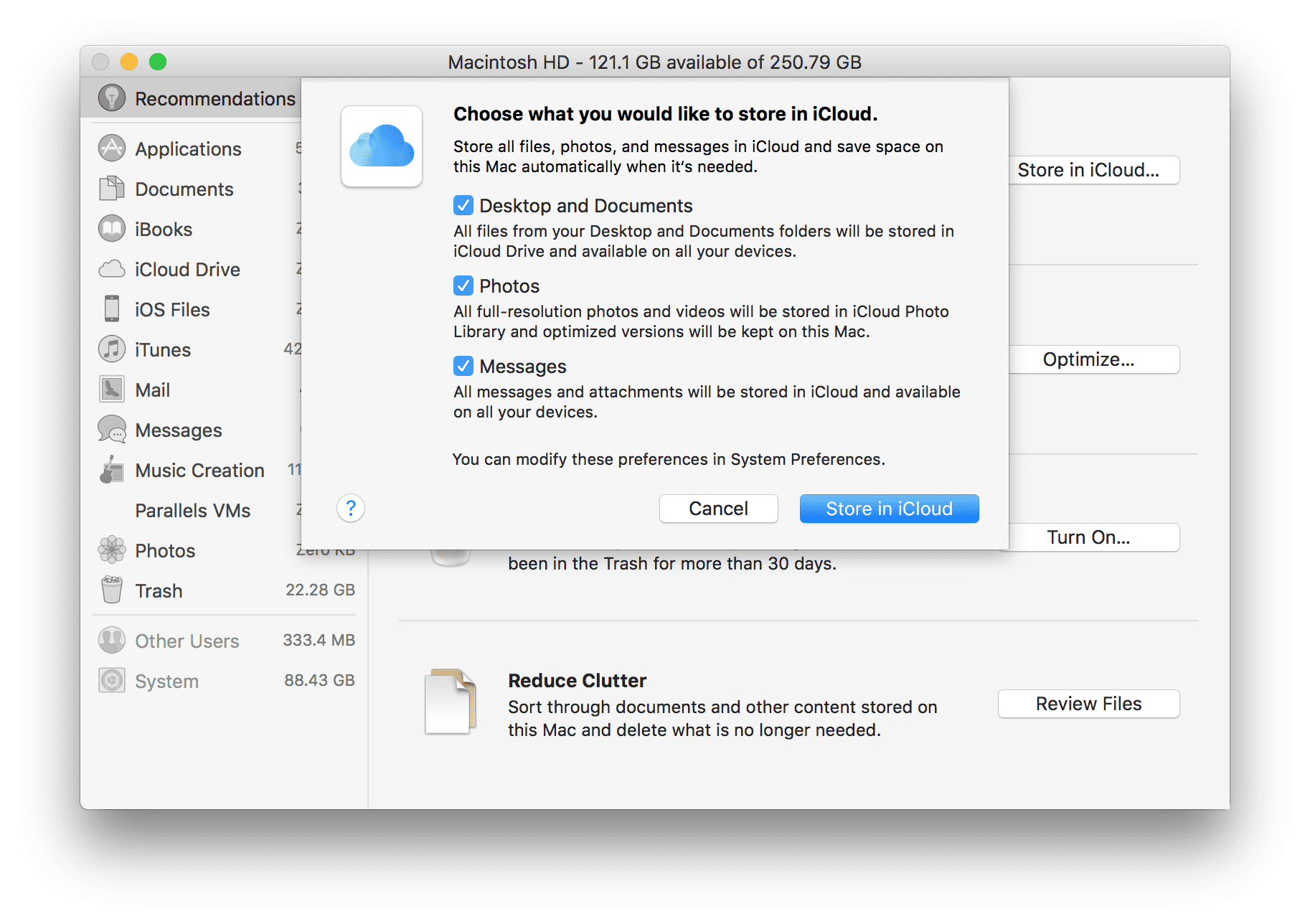
• Store in iCloud – This feature allows users to shop their desktop, documents, photos, and videos in iCloud; macOS volition automatically complimentary upward local deejay infinite every bit needed. This is a wonderful solution to saving some space on your local disk/hard drive, simply it also can get expensive. iCloud storage gives you lot five GB of free storage when you sign up. If yous need more than space, you tin always upgrade to a larger storage program. The average price is Usa$0.99 for 50 GB, $ii.99 for 200 GB, or a price-saving alternative of $ix.99 for 2 TB. Y'all can find an Apple tree® back up folio listing the pricing, likewise every bit family pricing. Nonetheless, this is billed monthly and tin can quickly add upward over fourth dimension.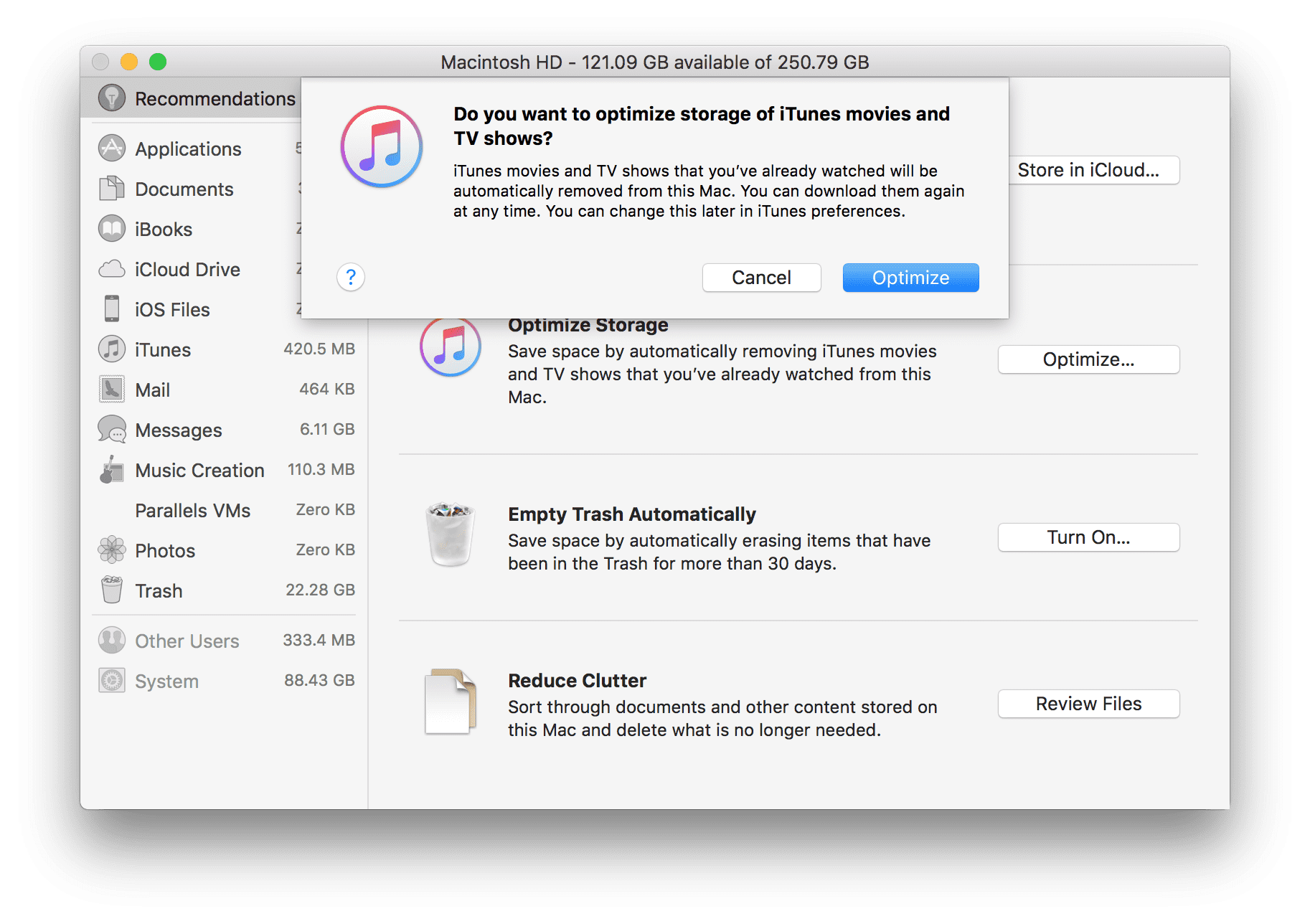
• Optimize Storage – The vague name doesn't quite match the feature, just it basically deletes your purchased iTunes movies and TV shows after you've watched them to keep them from cluttering up your difficult bulldoze. Since Hard disk movies, especially in 4k format, are extremely large files, this can help keep your Mac from running out of space without thinking about it. You can, of form, download them once more any time if you lot've purchased them from your Apple tree account.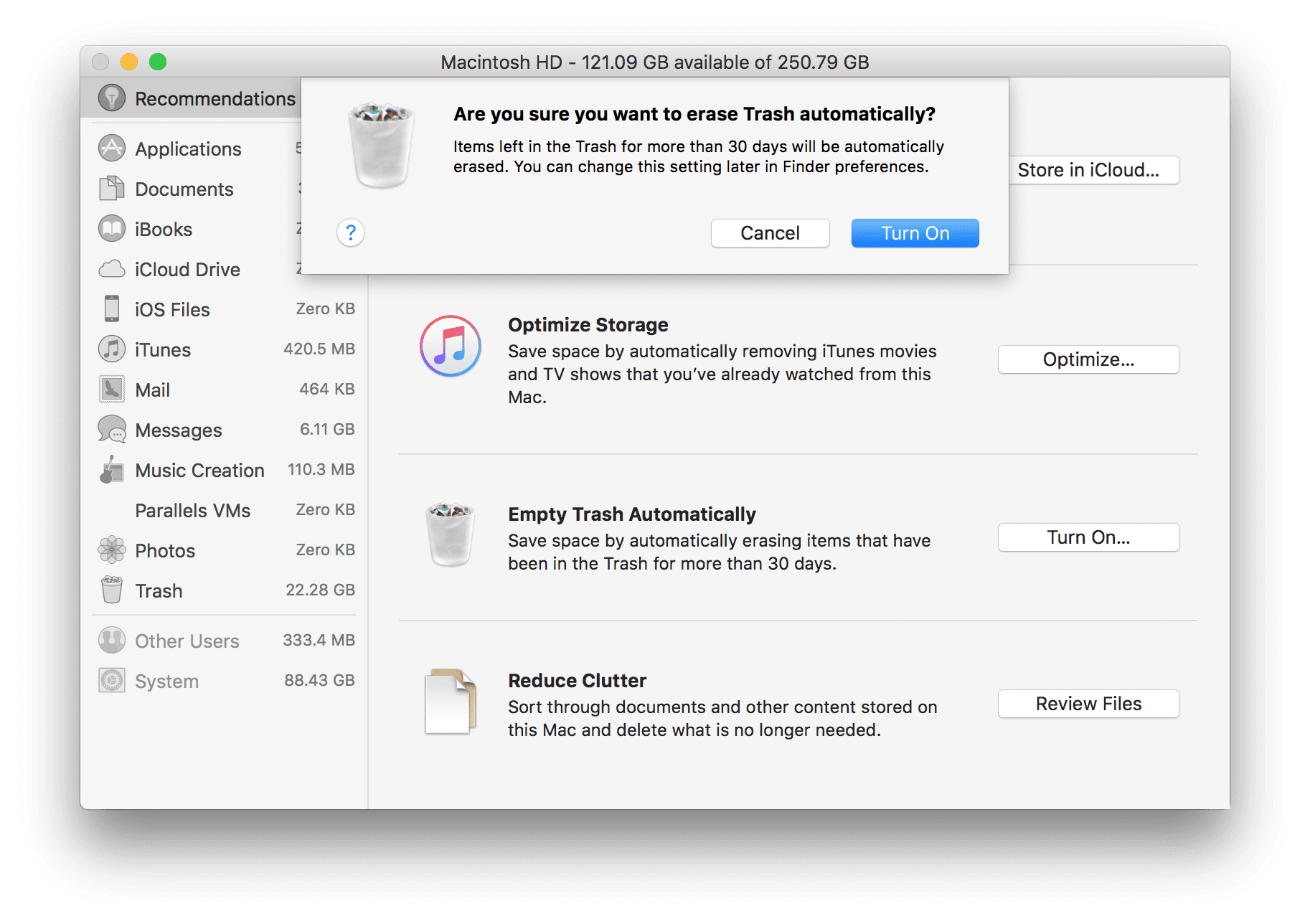
• Empty Trash Automatically – This is fairly uncomplicated and easy to do. If you lot turn this on, macOS will automatically delete quondam items out of the trash after 30 days. The downside to this is if you frequently delete files so go back and attempt to observe them—they're gone. Tin't get them back.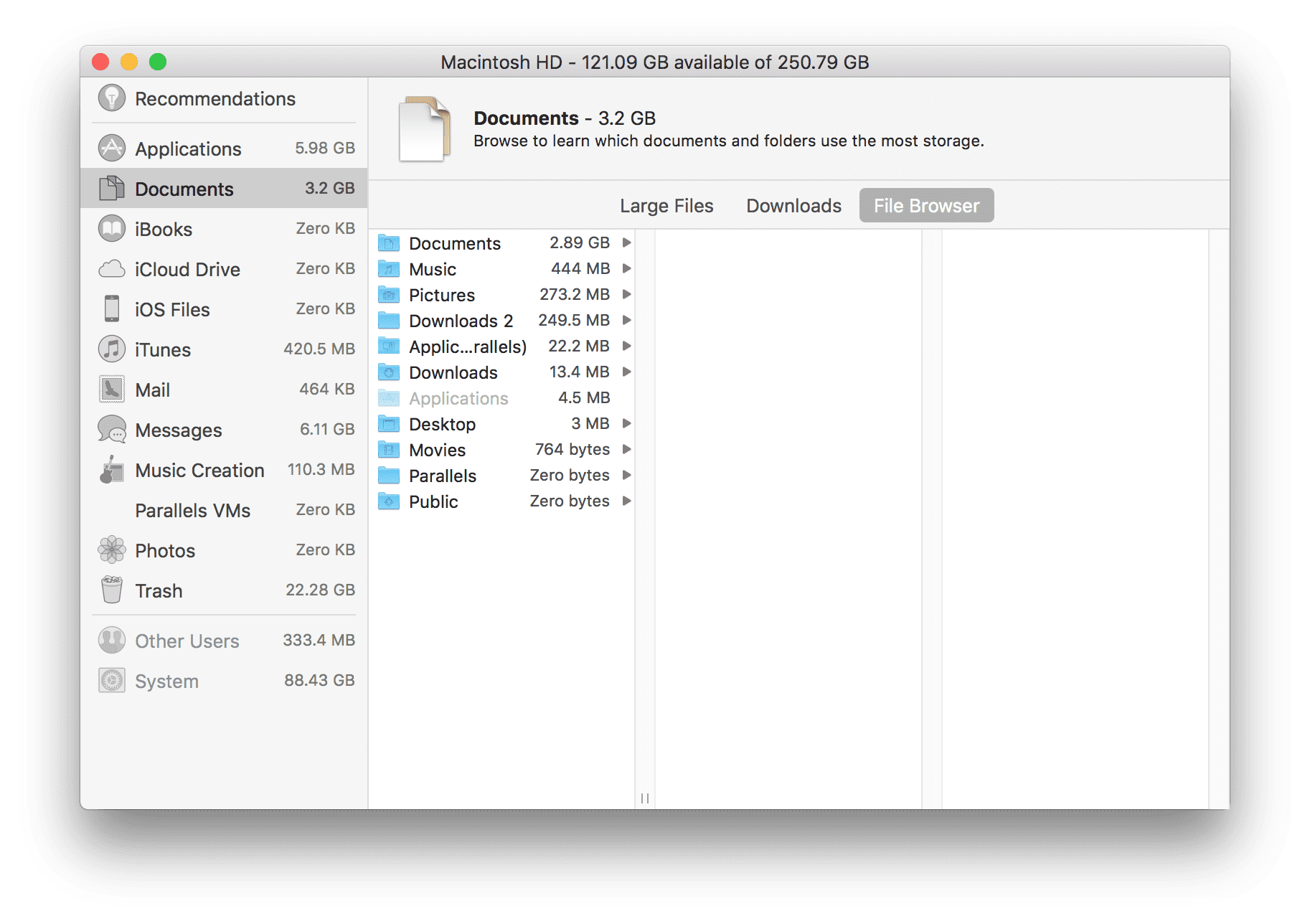
• Reduce Clutter – With this straightforward tool, you can detect the biggest files on your difficult drive and delete them. Organizing by "File Browser" seems to be the most helpful to browse the documents and folders that use the most storage. Then you tin can hands delete as desired.
Note: At that place are a lot of options to gratuitous upward extra disk space on your difficult bulldoze. However, some of these options are timely and accept away from other projects you lot could be working on. The Make clean Drive tool in Parallels® Toolbox keeps your Mac ataxia-gratuitous and running at max speed. It automatically scans, detects, and lets you choose what to delete—all with one click. No micromanagement to optimize your disk space—Parallels Toolbox does the dirty work for you.
Overdue for Hardware Upgrades
This is just a no-brainer to brand MacBook Pro® faster. Maintaining your computer's hardware wellness is imperative to getting the nigh out of your Mac for the longest amount of time possible. The most popular and best hardware upgrade for a solid performance boost is an upgrade to your hard bulldoze and RAM.
Before making an expensive buy and upgrading your hardware and replacing your hard drive or RAM, you can try an additional process by simply resetting your parameter random access retentivity (PRAM). Considering PRAM is used in Macintosh environments with a battery to retain system information, information technology can be a helpful tip.
Note: Intel-based Mac computers too accept a organisation management controller (SMC) that manages fans, lights, power, and system performance. You tin reset your PRAM with the following steps:
i. Shut downwardly your Mac. Yep, shut information technology all the way down. Putting your Mac to sleep or logging out will not work.
two. Notice the post-obit keys: Control+Option+P+R. You lot will need to concord these keys down in stride four.
3. Turn on your Mac.
4. Immediately press and hold Control+Option+P+R. Yous must press this cardinal combination before the grayness boot screen appears.
five. Continue holding the keys down until the computer restarts and you hear the startup chime for the second time.
half-dozen. Release the key combination.
Resetting PRAM and SMC may change some system settings such equally alarm clock, fans, lights, mouse speed, ability deportment, startup disk, virtual memory, disk cache, and more preferences. Don't worry—simply get into your Apple tree System Preferences and change your desired settings. Apple will always suggest resetting the PRAM start earlier resetting the SMC or doing a hardware upgrade.
Your computer operating with a lack of RAM is a tricky state of affairs to be in, but it has a relatively easy solution. Recall of your RAM like a workbench; the more space yous accept on your workbench, the more projects you lot can accept out and be actively working on. The well-nigh contempo macOS releases such as El Capitan, Sierra, and High Sierra volition but operate with a minimum 4 GB of RAM. This means that if you lot accept a full of 8 GB of RAM, you only take 4 GB to use for applications or multitasking. Most Mac computers ship from production with 4 GB of RAM; the latest iMac Pro® can be customized up to 128 GB of 2666MHz DDR4 ECC memory. All the same, not all RAM is the same. If your system is low on RAM, you'll be able to come across small indicators such as a irksome load time or a spinning pinwheel of death, aka the spinning beach brawl, aka the Apple tree spinning "load" wheel.
When it comes to doing a physical hardware upgrade of your RAM, y'all'll need to figure out what type of RAM your Mac uses and the maximum installation information technology will take.
To figure out what blazon of RAM your Mac uses, follow this pathway:
Apple Logo > About this Mac > Overview

On this window, yous tin see the memory in this Mac is 16 GB of DDR3 RAM. To get a deeper understanding of your calculator's hardware, click the "System Study" button to pull upwards the System Information Window.
This is where you lot'll see your internal hardware listed on the left-hand side. When looking at the screenshot, it's now clear that there are 2 slots (also known as banks) with 8 GB of DDr3 RAM in each slot. This adds up to a total of 16 GB of RAM in this MacBook.
If you lot're unsure how much memory your Mac can be updated to, and so the Apple tree knowledge-base documents should show you the maximum allocation of your system:
• MacBook Pro
• MacBook
• Mac Mini
• iMac
• Mac Pro
Replacing RAM is as easy as click out, click in, spiral on the plate, and boot your Mac to see a difference in everyday performance—but some Mac models cannot be upgraded since the RAM is glued and soldered into place. While replacing the RAM tin be an easy fix, it can also go a costly solution. RAM more often than not ranges betwixt $xx–$200 per stick, depending on the size and type.
A solid-state hard bulldoze upgrade can make a huge difference in your everyday experience, regardless of what you may exist using your computer for. Upgrading an older Mac figurer'southward traditional rotating hard drive to a solid-land drive (SSD) is similar breathing new life into a "dying" estimator. Benefits of an SSD include better efficiency for energy consumption, more reliable, and quieter operation. Over the last few years, the pricing for SSDs has come down enough to be considered a reasonable investment for an older Mac.
How do you get-go the procedure of replacing your Mac estimator's internal hard drive with a new solid-state bulldoze? Information technology's quite an like shooting fish in a barrel task and not as challenging as you may call back.
What Models of Mac Can Have the Internal Difficult Drive Upgraded?
iMac – Older to 2017 (electric current) models
Mac mini – Older to late 2014 (current) models
Mac Pro – Older to late 2013 (current) models
MacBook – Older to mid-2010 models
MacBook Air – Older to 2017 (current) models
MacBook Pro – Older to mid-2015 models
Note: if your Mac has a SuperDrive®, aka a deejay drive, you can replace the SuperDrive with the solid-state drive, merely your SSD upgrade may not run as fast due to the internal Mac connections to the SuperDrive.
What You'll Need:
• A 2.five" SATA SSD
• SATA-to-USB cablevision or dock
• Tiny screwdriver to open your laptop (when we say tiny, we mean tiny. Phillips #00)
• Torx head screwdriver for disassembling the hard drive
• Stiff loving cup of java to continue yous motivated
Apple doesn't (and has never) encouraged users to open their Mac, permit lone exercise hardware upgrades themselves. Because of this, it'southward impossible to discover whatsoever documentation directly from Apple regarding an SSD upgrade. Yet, there are tons of wonderful third-party resources such every bit iFixIt.com. A helpful parcel to purchase is the upgrade kit specifically created by iFixIt.com. It ranges from US$135 for a 25 6GB SSD upwardly to $370 for a ane TB SSD. It's highly encouraged to research your Mac computer'south model type and make sure it can be upgraded prior to buying whatsoever replacement kits.
Notation: Don't forget to back upwardly your Mac! Your data is imperative to ensure you keep working in a way yous're used to. You tin can also move your existing hard bulldoze onto an external bulldoze case and use it as a portable drive. Nevertheless, this is a great opportunity to start fresh, too! Once you lot install a new hard drive, you'll need to install the macOS.
Tiresome Power-Up
At that place are countless variables in a Mac, the macOS, or a user's behavior that could be a direct cause for a slow power-up. To ensure that we cover the about influential variables, we'll directly move into the top three reasons your Mac might be slowing downward. Our acme tips include removing unused applications, turning off any Login Items, and deleting sometime cache/logs.
Remove Unused Applications
Deleting or removing unused applications is quite piece of cake and a quick fashion to save a ton of infinite. You can uninstall applications y'all got from the Mac App Store, from third-party websites, or from physical discs/USB drives. You tin't uninstall applications that are native to the macOS, such as Safari, Mail, and Arrangement Preferences.
To get started with deleting unused applications, get alee and take the following pathway:
Finder > Go > Applications (or keyboard philharmonic Shift + Control + A)
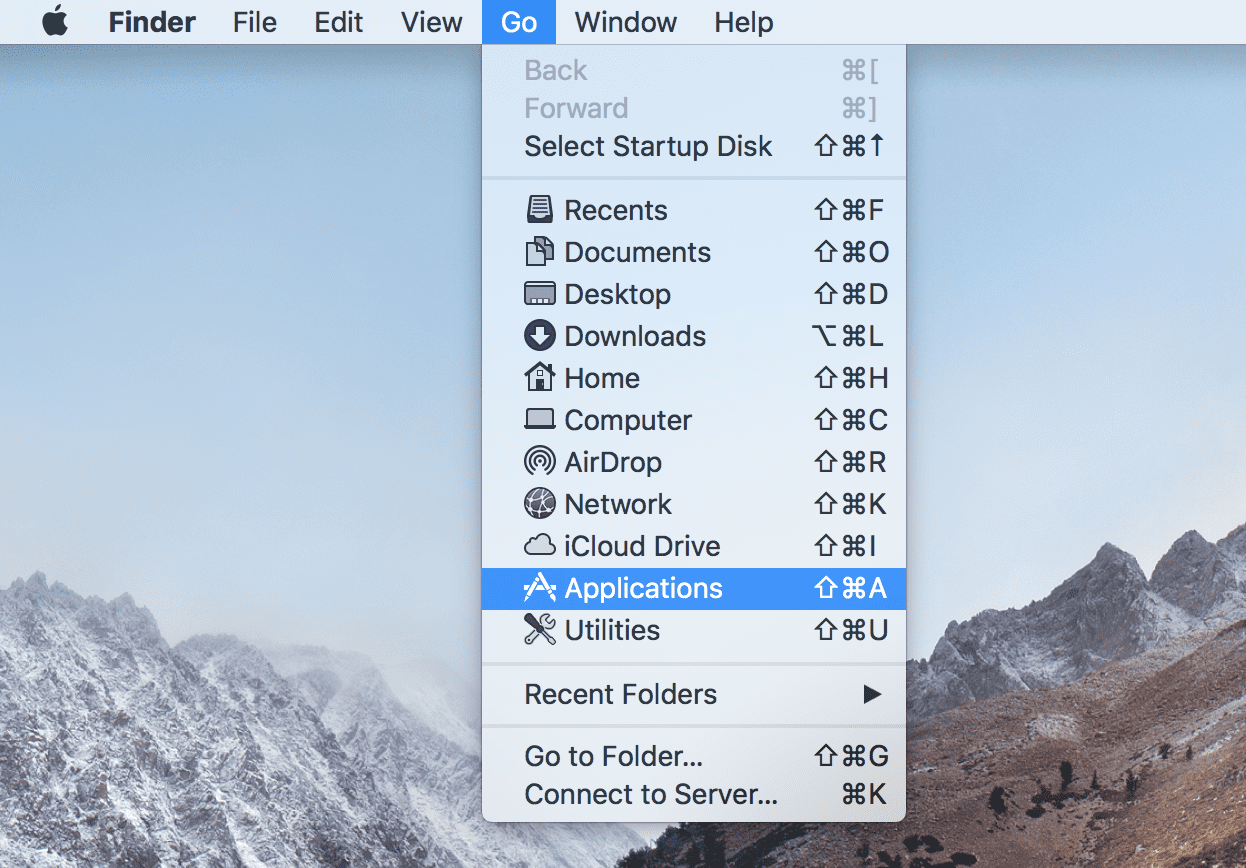
This will bring up your entire Applications Folder with all applications that are installed on your Mac hard bulldoze. I would propose changing the View of this binder to "List" mode so organizing the list past size to easily run across which applications are taking up the most infinite.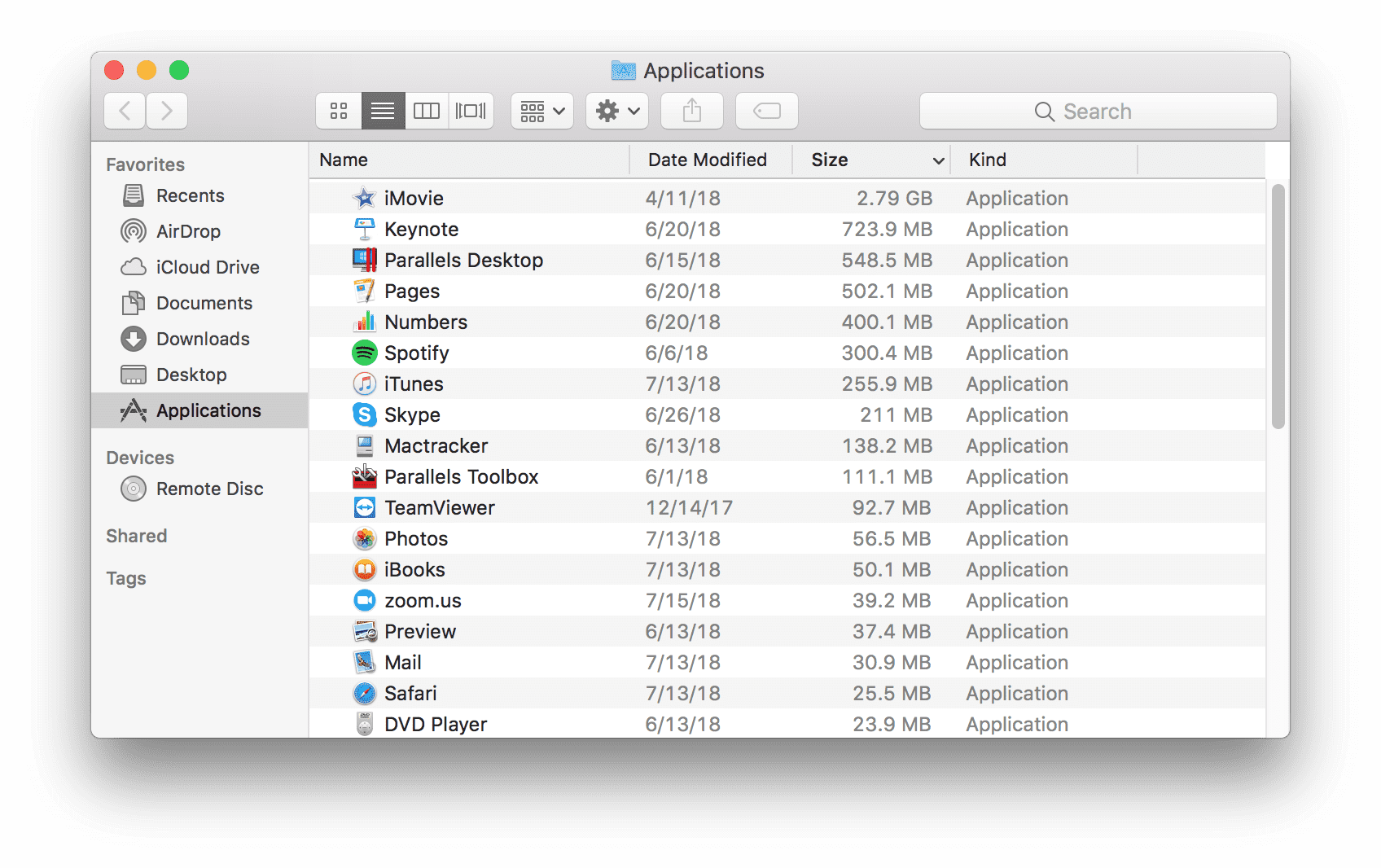
You can and then delete your desired awarding by right-clicking and selecting "Move to Trash."
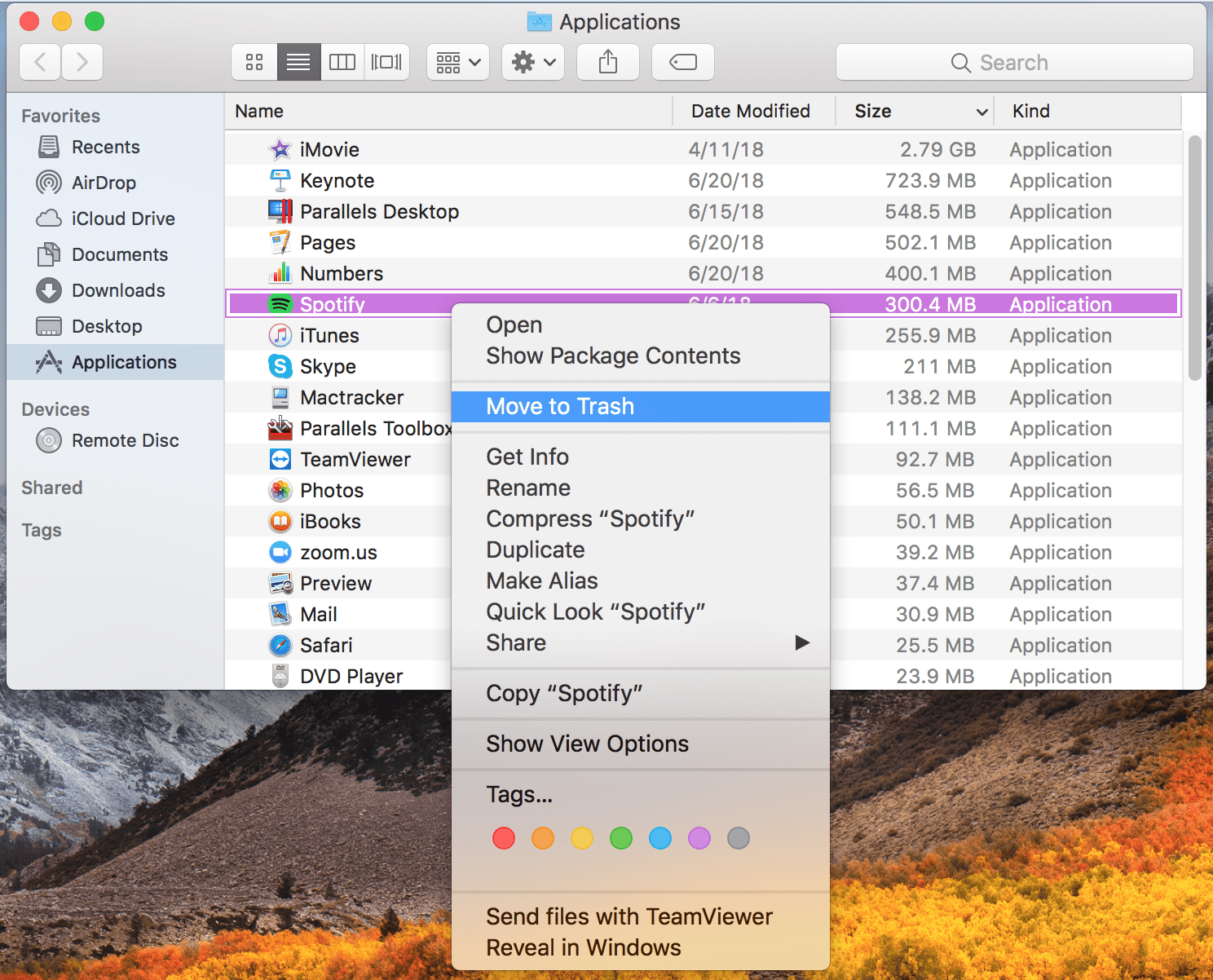
…or by dragging your desired application straight to the Trash icon in your macOS Dock.
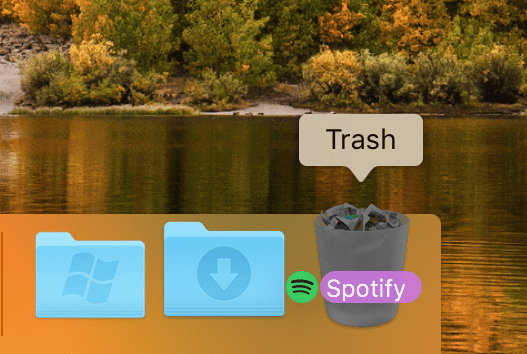
There is one last step: you must empty the Trash to remove the data from your hard drive to free up that disk space. Check the Trash to see if at that place is anything y'all want to save. To move forrad, simply correct-click your Trash icon in the macOS dock and click "Empty Trash."
Note: When you empty the Trash, the awarding is permanently removed from your Mac, and you cannot become information technology back without re-downloading it from an external source such as a website, disk, USB drive, or carrier pigeon.
Turn Off Login Items
The second tip for speeding up a slow power-up or kicking is to plow off any Login Items when you lot power up your Mac. To practise this, follow the steps below:
Settings > Users & Groups > Current User > Login Items
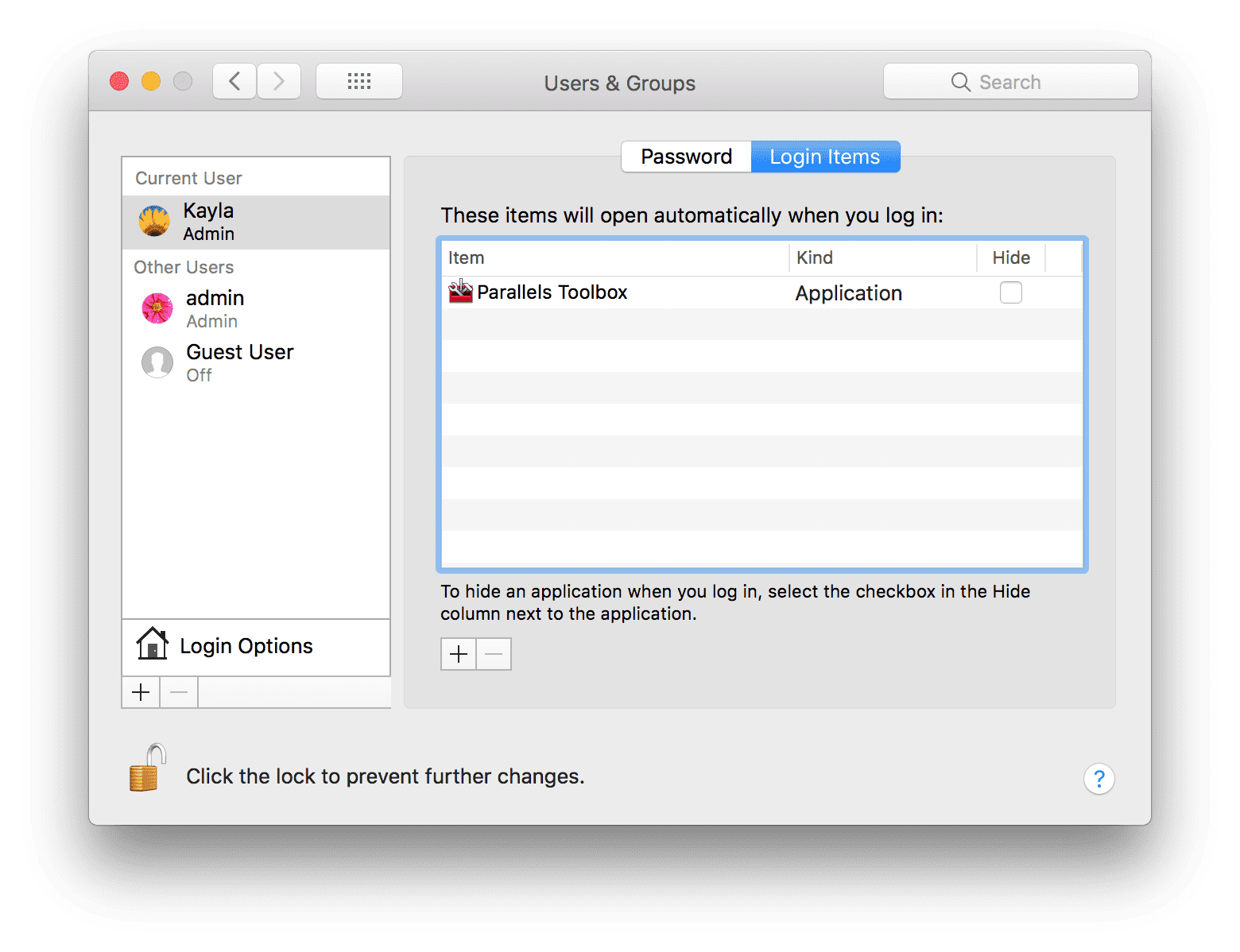
Select the items y'all want to remove > Click the "-" button.
Notation: When yous install some applications, they might exist automatically added to your Login Items, and they volition launch when yous start your Mac. Over fourth dimension, if yous're not paying attending to what you download, and you rarely restart your Mac, this can cause some serious slowdown. Yous'll end upwards feeling very familiar with that spinning beachball of decease.
Delete Cache and Temporary Files
The last tip that will quickly speed upwardly your slow start up is to delete user cache and temporary files.
Cache files can be described as temporary information stored on your hard drive to speed upwardly known processes that the user performs. For example, cache is frequently used in web browsers such equally Safari. Safari will download website images as enshroud to ensure that the next fourth dimension you visit that website, y'all don't have to re-download the images and you lot can offset interacting with the webpage quicker. Withal, over fourth dimension, cache files build up and take up storage on your hard drive, ultimately slowing down your Mac. Cache and temporary files tin include many things other than spider web browsers—messages, app-specific temporary files, downloads, so much more.
To clear cache and temporary files from the agile user, follow the next steps:
Finder > Go > Library > Hold down the "Option" key on your keyboard > Select "Library"
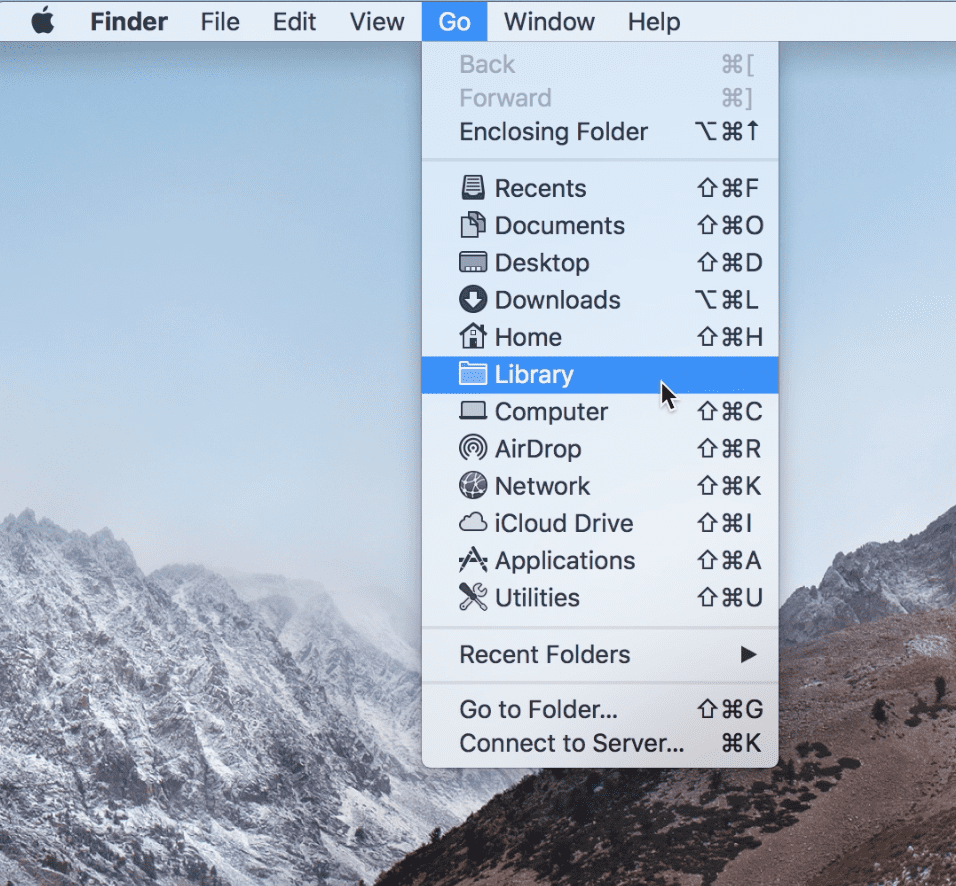
Once you lot locate and open the Library folder, locate the "Caches" binder and manually choose which caches and temporary files to clear. Alternatively, you tin select all, right click, and select "Move to Trash."
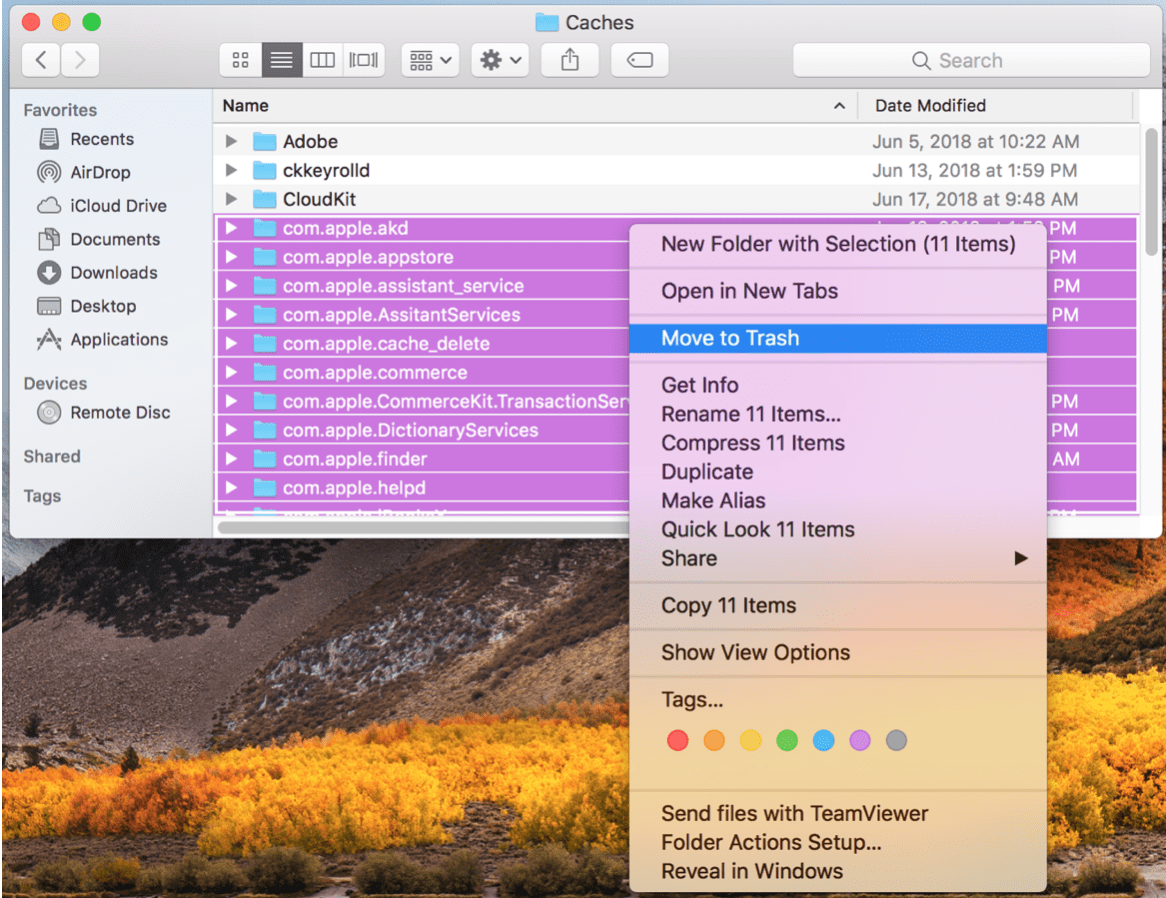
Clearing caches and temporary files on a Mac is non something you should need to perform regularly. Mostly, yous'd only want to clear caches if they're hogging a vast corporeality of storage chapters, or if an awarding is non working properly due to previously saved data from old cache. Keep reading to the end of this blog postal service to learn how yous can relieve an incredible nearly of fourth dimension with the Parallels Toolbox Clean Drive tool and achieve the above steps with 1 click.
Out-of-Appointment Software
Keeping your Mac up to appointment is disquisitional.
Why?
Offset, information technology helps ensure you're getting the near out of your Mac and it's running as fast as information technology tin can.
2d, those minor updates are ofttimes there to address bug with battery life, bugs, or even massive security changes.
Don't like constant updates and feel similar they get in the way of your productivity? Do you also ignore those notifications and look as long as possible earlier ever doing an update? Even if you have things to do, people to talk to, or projects to complete, too bad!
How to Update the Software on Your Mac
Employ the Mac App Store to update the macOS and any applications yous downloaded or purchased from the App Shop. 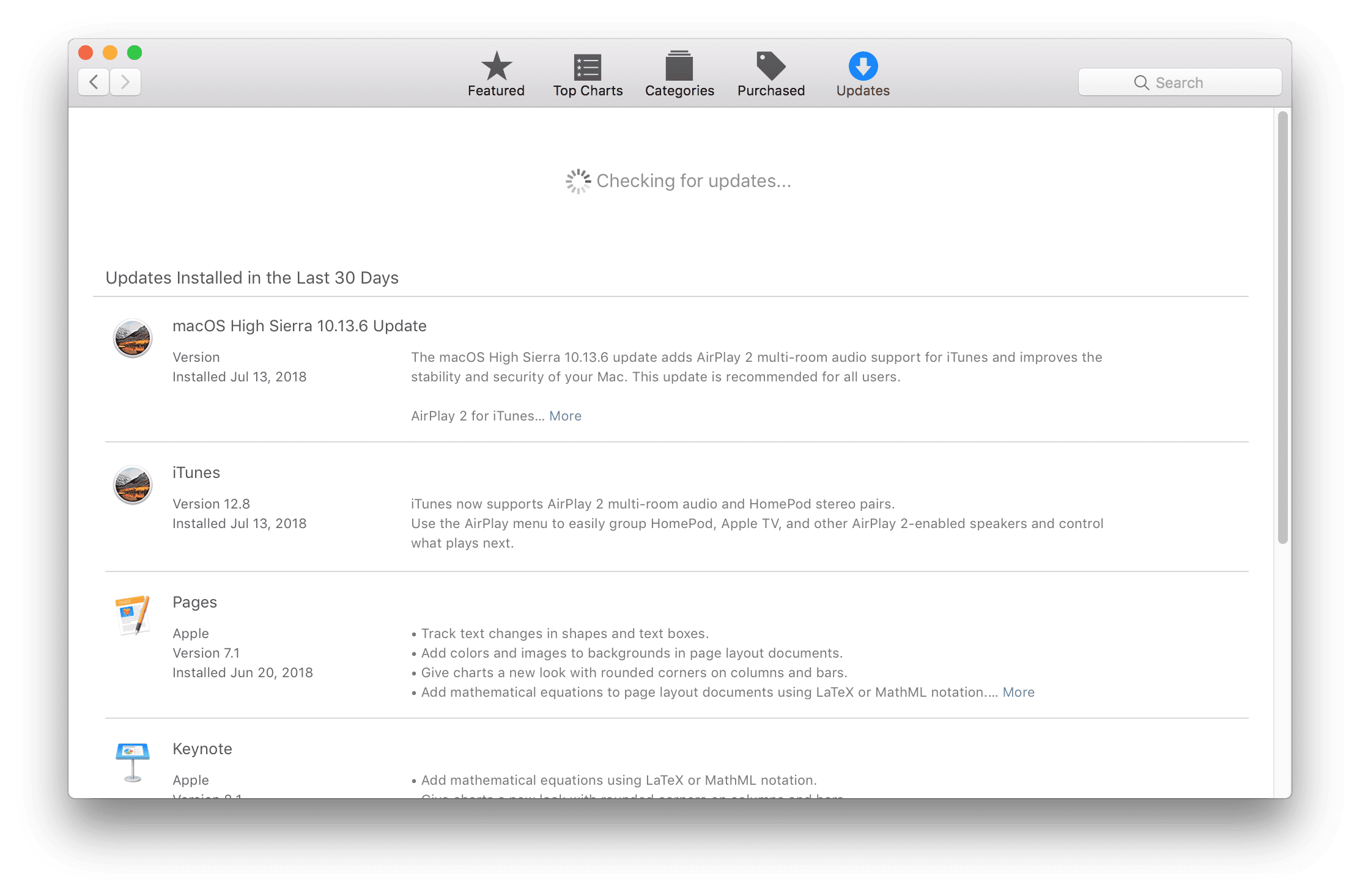
Regularly click Updates in the App Store toolbar, then employ the Update buttons to download and install whatever updates listed. Any updates installed in the concluding 30 days announced below this listing, too. You tin get one step further by selecting your App Store settings in System Preferences to automatically bank check for updates, and fifty-fifty download newly available updates in the groundwork. Don't worry, you'll be notified when the updates are ready to be installed and if it will interrupt your work or cause a restart. This is a serious PSA: update your applications, people!
Note: Regular backups will help ease that fear of updating. If your backups are upward to appointment with your data, then you should exist able to update without fright!
We've addressed the acme issues that tin can cause a Mac reckoner's performance to slow downwards, likewise as five quick native macOS solutions to speed up your Mac. Nosotros mentioned that as a bonus, we'll also cover handy i-click tools that can save time, coin, and quickly gratuitous upward your precious disk infinite without abrasive micromanagement of your system. Here are our favorite tools that take helped users optimize their disk and organisation:
- Parallels Toolbox Clean Bulldoze – Keep your Mac clutter-gratuitous and running at max speed. Scans, detects, and lets you cull what to delete.
- Parallels Toolbox Gratuitous Memory – Gratis up unused computer memory with 1 click.
- Parallels Toolbox Notice Duplicates – Search any drive or binder to quickly find identical files (even with different names) and gratis up disc space.
Parallels Toolbox is bachelor on macOS and Windows. It's an all-in-ane package with a dozen time-saving tools to aid optimize your workday.
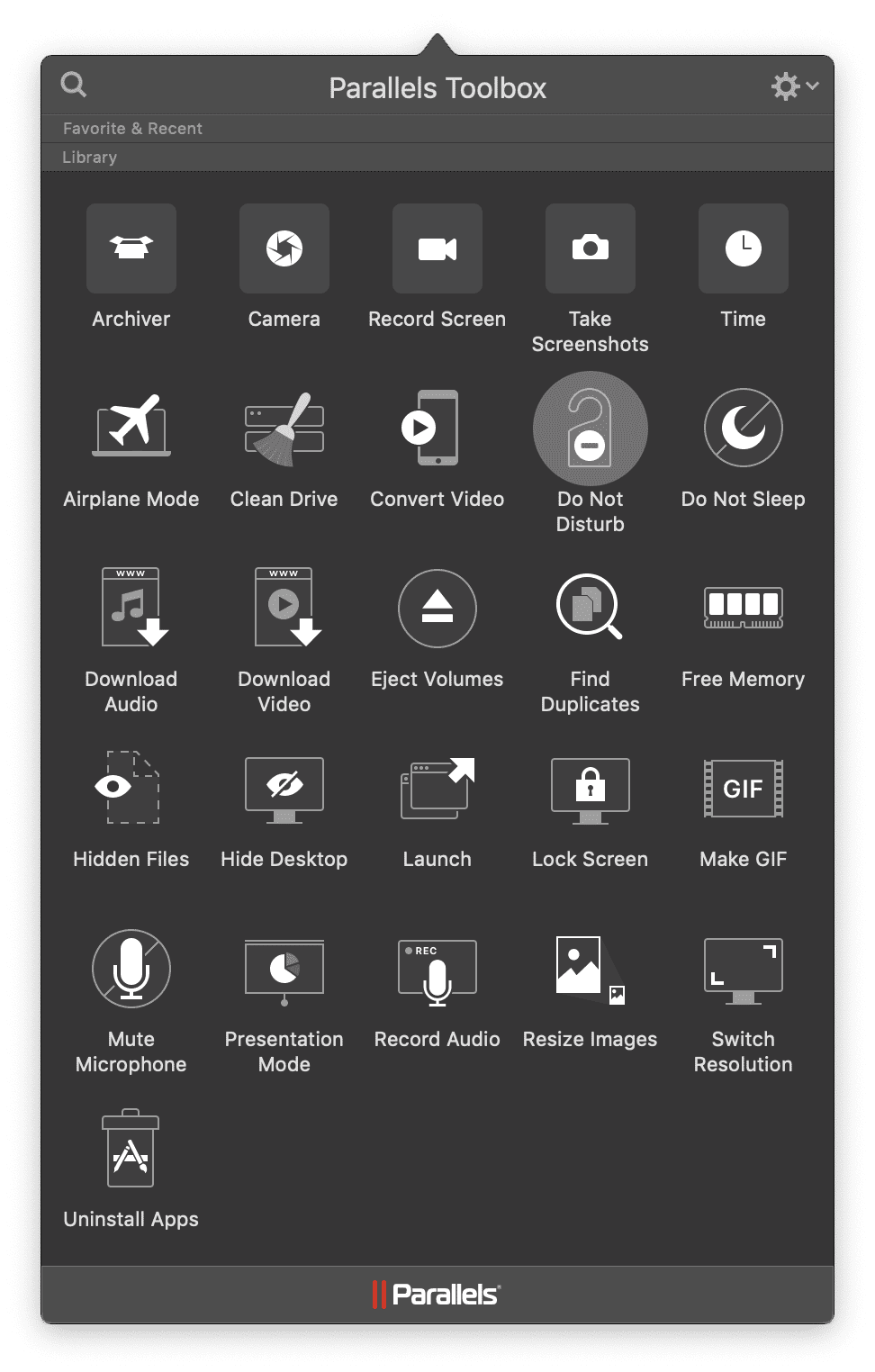
• Created with both basic and power users in listen. Modest business owners, developers, or IT users who need to save space with a unproblematic set of tools are empowered to practise then with this suite.
• Easily optimize your difficult drive's storage with easy-to-use tools similar Clean Bulldoze, Observe Duplicates, or Free Memory. Free up extra disk space yous didn't know you had!
• Be in complete command of your privacy with reliable organisation tools such as Airplane Mode, Disable Camera, Lock Screen, and Mute Microphone.
• Manage your ever-changing workflow with Archive for your files, Squirt Volumes for external drives, or Switch Resolution for external monitors.
Optimizing your boring Mac to run quickly is a difficult chore only can be easily done with the steps in a higher place or Parallels Toolbox. Parallels Toolbox for Mac and see how easy information technology is to speed up your Mac.
Now It'south Your Turn! These are my best strategies to go along a Mac at its best functioning and forbid it from ever slowing downward. Now nosotros'd like to hear from you! Which strategy from this guide are you going to try first? Do you have whatever personal tactics that work best for you or any issues optimizing your Mac? Either way, let u.s. know past leaving a annotate beneath or reaching out to our team on Facebook or Twitter.
Source: https://www.parallels.com/blogs/mac-running-slow/
0 Response to "Mac Acting Super Funny Things Crashing"
Postar um comentário